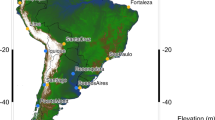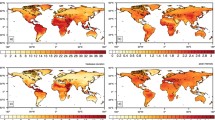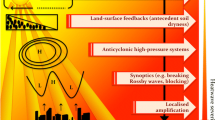Abstract
Observational analysis and climate modeling efforts concur that the frequency, intensity, and duration of heatwaves will increase as the Earth’s mean climate shifts towards warmer temperatures. While the impacts and mechanisms of heatwaves have been well explored, extreme temperatures over Florida are generally understudied. This paper sheds light on Floridian heatwaves by exploring 13 years of daily data from surface observations and high-resolution WRF climate simulations for the same timeframe. The characteristics of the current and future heatwaves under the RCP8.5 high emissions scenario for 2070–2099 were then investigated. Results show a tripling in the frequency, and greater than a sixfold increase in the mean duration of heatwaves over Florida when the current standard of heatwaves was used. The intensity of heatwaves also increased by 4–6 °C due to the combined effects of rising mean temperatures and a 1–2 °C increase attributed to the flattening of the temperature distribution. Since Florida’s atmospheric boundary layer is rich in moisture and heatwaves could further increase the moisture content in the lower troposphere, the relationship between heatwaves and extreme precipitation was also explored in both the current and future climate. As expected, rainfall during a heatwave event was anomalously low, but it quickly recovered to normal within 3 days after the passage of a heatwave. Finally, the late 21st-century climate could witness a slight decrease in the mean precipitation over Florida, accompanied by heavier heatwave-associated extreme precipitation events over central and southern Florida.










Similar content being viewed by others
References
Anderson GB, Bell ML (2009) Weather-related mortality: a study of how heat, cold, and heat waves affect mortality in the United States. Epidemiology 20:205–213
Borden KA, Cutter SL (2008) Spatial patterns of natural hazards mortality in the United States. Int J of Health Geographics 7:64
Census Bureau US (2012) 2010 Census of Population and Housing, Summary Population and Housing Characteristics, CPH-1-11. Florida U.S. Government Printing Office, Washington, DC, 2012
Changnon SA, Kunkel KE, Reinke BC (1996) Impacts and responses to the 1995 heat wave: A call to action. Bull Amer Meteor Soc 77:1497–1506
Cloutier-Bisbee SR, Raghavendra A, Milrad SM (2018) Floridian Heatwaves and Extreme Precipitation. Part I: Observations and Trends, 31st Conference on Climate Variability and Change, Austin, TX, Amer Meteor Soc 15B.1
Cubit (2015) Florida Cities by Population. Cubit Planning, Inc. http://www.florida-demographics.com/cities_by_population. Accessed 15 April 2017
Curran EB, Holle RL, Lopez RE (2000) Lightning casualties and damages in the United States from 1959 to 1994. J Clim 13:3448–3464
Dai A, Rasmussen RM, Liu C, Ikeda K, Prein AF (2017) A new mechanism for warm-season precipitation response to global warming based on convection-permitting simulations. Clim Dyn. https://doi.org/10.1007/s00382-017-3787-6
Dee DP, Uppala SM, Simmons AJ et al (2011) The ERA-Interim reanalysis: configuration and performance of the data assimilation system. Q J R Meteorol Soc 137:553–597
DeGaetano AT, Noon W, Eggleston KL (2015) Efficient access to climate products using ACIS web services. Bull Amer Meteor Soc 96:173–180
Doswell CA III (1987) The distinction between large-scale and mesoscale contribution to severe convection: A case study example. Wea Forecast 2:3–16
Estoque MA (1962) The sea breeze as a function of the prevailing synoptic situation. J Atmos Sci 19:244–250
Fischer EM, Schär C (2009) Future changes in daily summer temperature variability: driving processes and role for temperature extremes. Clim Dyn 33:917–935
Florida Department of Health, Division of Community Health Promotion, Public Health Research Unit (2015) Health effects of summer heat in Florida. http://www.floridahealth.gov/environmental-health/climate-and-health/_documents/heat-profile.pdf. Accessed 1 Apr 2017
García-Díez MJ, Fernández J, Fita L, Yagüe C (2013) Seasonal dependence of WRF model biases and sensitivity to PBL schemes over Europe. Q J R Meteorol Soc 139:501–514
Gentry RC, Moore PL (1954) Relation of local and general wind interaction near the sea coast to time and location of air-mass showers. J Meteor 11:507–511
Greene S, Kalkstein L, Mills D, Samenow J (2011) An examination of climate change on extreme heat events and climate-mortality relationships in large U.S. cities. Wea Clim Soc 3:281–292
Hodanish S, Sharp D, Collins W, Paxton C, Orville RE (1997) A 10-yr monthly lightning climatology of Florida: 1986–95. Wea Forecast 12:439–448
Hubbard KG, DeGaetano AT, Robbins KD (2004) SERVICES: A modern applied climate information system. Bull Amer Meteor Soc 85:811–812
IPCC (2012) Summary for policymakers. In: Field CB, Barros V, Stocker TF, Qin D, Dokken DJ, Ebi KL, Mastrandrea MD, Mach KJ, Plattner GK, Allen SK, Tignor M, Midgley PM (eds) Managing the risks of extreme events and disasters to advance climate change adaptation. A Special Report of Working Groups I and II of the Intergovernmental Panel on Climate Change. Cambridge University Press, Cambridge, pp 3–21
IPCC (2013) Summary for policymakers. In: Stocker TF, Qin D, Plattner GK, Tignor M, Allen SK, Boschung J, Nauels A, Xia Y, Bex V, Midgley PM (eds) Climate Change 2013: the physical science basis. Contribution of Working Group I to the Fifth Assessment Report of the Intergovernmental Panel on Climate Change. Cambridge University Press, Cambridge
Keellings D, Waylen P (2014) Increased risk of heat waves in Florida: Characterizing changes in bivariate heat wave risk using extreme value analysis. Appl Geog 46:90–97
Keellings D, Waylen P (2015) Investigating teleconnection drivers of bivariate heat waves in Florida using extreme value analysis. Clim Dyn 44:3383–3391
Kingsmill DE (1995) Convection initiation associated with a sea-breeze front, a gust front, and their collision. Mon Wea Rev 123:2913–2933
Lin Y, Mitchell KE (2005) The NCEP Stage II/IV hourly precipitation analyses: development and applications. Preprints, 19th Conf. on Hydrology, San Diego, 9–13 January 2005, Amer Meteor Soc 1.2. https://ams.confex.com/ams/pdfpapers/83847.pdf
Liu C, Ikeda K, Rasmussen RM et al (2017) Continental-scale convection-permitting modeling of the current and future climate of North America. Clim Dyn 49:71–95
Luber GE, Sanchez CA, Conklin LM (2006) Heat-related deaths–United States, 1999–2003. MMWR 55(29):796–798
Milrad SM, Herbster CG (2017) Mobile radar as an undergraduate education and research tool: the ERAU C-BREESE field experience with the doppler on wheels. Bull Amer Meteor Soc 98:1931–1948
Perkins SE (2015) A review on the scientific understanding of heatwaves—Their measurement, driving mechanisms, and changes at the global scale. Atmos Res 164:242–267
Perkins SE, Alexander LV (2013) On the measurement of heat waves. J Clim 26:4500–4517
Prein AF, Langhans W, Fosser G et al (2015) A review of regional convection-permitting climate modeling: demonstrations, prospects, and challenges. Rev Geophys 53:323–361
Prein AF, Rasmussen RM, Ikeda K et al (2017) The future intensification of hourly precipitation extremes. Nature Clim Change 7:48–52
Riahi K, Rao S, Krey V et al (2011) RCP 8.5—a scenario of comparatively high greenhouse gas emissions. Clim Change 109:33–57
Robinson FJ, Patterson MD, Sherwood SC (2013) A numerical modeling study of the propagation of idealized sea-breeze density currents. J Atmos Sci 70:653–668
Schär C, Vidale PL, Lüthi D et al (2004) The role of increasing temperature variability in European summer heatwaves. Nature 427:332–336
Skamarock WC, Klemp JB, Dudhia J et al (2008) A description of the advanced research WRF Version 3, Tech. Rep. NCAR/TN-475 + STR, Natl Cent Atmos Res, Boulder, Colo. http://www2.mmm.ucar.edu/wrf/users/docs/arw_v3.pdf
Trenberth KE (1998) Atmospheric moisture residence times and cycling: Implications for rainfall rates with climate change. Clim Change 39:667–694
Wehner M, Stone D, Krishnan H, Achutarao K, Castillo F (2016) The deadly combination of heat and humidity in India and Pakistan in summer 2015 [in “Explaining Extremes of 2015 from a Climate Perspective”]. Bull Amer Meteor Soc 97(12):S81–S86
Williams E, Boldib B, Matlinb A et al (1999) The behavior of total lightning in severe Florida thunderstorms. Atmos Res 51:245–265
Wu J, Zhou Y, Gao Y et al (2014) Estimation and uncertainty analysis of impacts of future heat waves on mortality in the eastern United States. Environ Health Perspect 122:10–16
Acknowledgements
The authors would like to thank Roy M. Rasmussen and others at NCAR who made the WRF simulations available to use, and Kyoko Ikeda (NCAR) in particular for her generous help by providing the necessary data, and information essential to analyzing the data files. This manuscript also benefitted from the constructive criticism and feedback from two reviewers. A. Raghavendra acknowledges funding support from the National Science Foundation (NSF #AGS-1535426). A. Dai acknowledges the funding support from the NSF (#AGS-1353740), U.S. Department of Energy’s Office of Science (Award #DE-SC0012602), and U.S. National Oceanic and Atmospheric Administration (Award #NA15OAR4310086).
Author information
Authors and Affiliations
Corresponding author
Rights and permissions
About this article
Cite this article
Raghavendra, A., Dai, A., Milrad, S.M. et al. Floridian heatwaves and extreme precipitation: future climate projections. Clim Dyn 52, 495–508 (2019). https://doi.org/10.1007/s00382-018-4148-9
Received:
Accepted:
Published:
Issue Date:
DOI: https://doi.org/10.1007/s00382-018-4148-9




